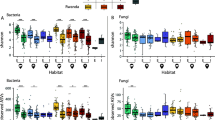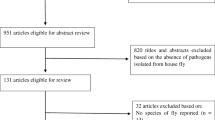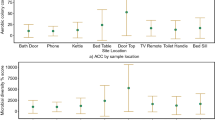Abstract
A total of 297 individuals of indoor Mus musculus Linnaeus, 1758 were trapped in two villages (Duplín and Potoky) in north-eastern Slovakia during 2015–2017 from small private farmstead buildings, i.e. in breeding yards with poultry, pigs and pigeons. Analysis of the demographic structure of the mouse populations showed that the sex ratio did not deviate from a 1:1 ratio. The prevalence of adult mice was significantly higher than of subadults, and this was particularly noticeable in females. The season did not affect the litter size (mean ± SD = 4.9 ± 1.5, with 2–8 embryos) in mice, and winter breeding was confirmed. Results from our microbiological analysis showed that the house mouse populations inhabiting small farmstead buildings could be important reservoirs of potentially pathogenic and multidrug-resistant bacteria.

Similar content being viewed by others
References
Allen S, Boerlin P, Janecko N, Lumsden JS, Barker IK, Pearl DL, Reid-Smith RJ, Jardine C (2011) Antimicrobial resistance in generic Escherichia coli isolates from wild small mammals living in swine farm, residential, landfill, and natural environments in southern Ontario, Canada. Appl Environ Microbiol 77(3):882–888. https://doi.org/10.1128/AEM.01111-10
Backhans A, Fellström C (2012) Rodents on pig and chicken farms – a potential threat to human and animal health. Infect Ecol Epidemiol 2(1):17093. https://doi.org/10.3402/iee.v2i0.17093
Balčiauskienė L, Balčiauskas L (2016) Pelvis of the striped field mouse Apodemus agrarius (Pallas, 1771): sexual dimorphism and relation to body weight. North West J Zool 12(1):50–57
Balčiauskienė L, Balčiauskas L, Vitkauskas V, Podėnas S (2015) Indoor small mammals in Lithuania: some morphometrical, body condition, and reproductive characteristics. Zool Ecol 25(4):305–313. https://doi.org/10.1080/21658005.2015.1086098
Boehme S, Werner G, Klare I, Klare I, Reissbrodt R, Witte W (2004) Occurrence of antibiotic-resistant enterobacteria in agricultural foodstuffs. Mol Nutr Food Res 48(7):522–531. https://doi.org/10.1002/mnfr.200400030
Bronson FH (1979) The reproductive ecology of the house mouse. Q Rev Biol 54(3):265–299
Čanády A, Mošanský L, Stanko M (2008) Biometrical characteristics comparison of two sympatric species of the Mus genus – Mus spicilegus and Mus musculus from eastern Slovakia. In: Adamec M, Urban P, Adamcová M (eds) Výskum a ochrana cicavcov na Slovensku VIII. Zborník referátov z konferencie (Zvolen), Štátna ochrana prírody SR, Centrum ochrany prírody a krajiny, Banská Bystrica, pp 52–62
Charalampopoulos D, Rastall R (2009) Prebiotics and probiotics science and technology. Springer-Verlag, New York
Csanády A, Mošanský L (2018) Skull morphometry and sexual size dimorphism in Mus musculus from Slovakia. North West J Zool 14(1):102–106
Csanády A, Stanko M, Mošanský L (2019) Are differences in variation and allometry in testicular size of two sibling species of the genus Mus (Mammalia, Rodentia) caused by female promiscuity? Mamm Res 64(1):31–38. https://doi.org/10.1007/s13364-018-0393-x
Eucast (2016) European Committee on Antimicrobial Testing: Breakpoint tables for interpretation of MICs and zone diameters version 6.0, 2016
Fenselau C, Havey C, Teerakulkittipong N, Swatkoski S, Laine O, Edwards N (2008) Identification of β-lactamase in antibiotic-resistant Bacillus cereus spores. Appl Environ Microbiol 74(3):904–906. https://doi.org/10.1128/AEM.00788-07
Frynta D, Slábová M, Váchová H, Volfová R, Munclinger P (2005) Aggression and commensalism in house mouse: a comparative study across Europe and the near east. Aggress Behav 31(3):283–293. https://doi.org/10.1002/ab.15555
Frynta D, Slábová M, Vohralík V (2009) Why do male house mice have such small testes? Zool Sci 26:17–23. https://doi.org/10.2108/zsj.26.17
Ganem G (2012) Behaviour, ecology, and speciation in the house mouse. In: Macholán M, Baird SJE, Munclinger P, Piálek J (eds) Evolution of the house mouse. Cambridge University Press, Cambridge, pp 373–406
Guerra B, Junker E, Schroeter A, Malorny B, Lehmann S, Helmuth R (2003) Phenotypic and genotypic characterization of antimicrobial resistance in German Escherichia coli isolates from cattle, swine and poultry. J Antimicrob Chemother 52(3):489–492. https://doi.org/10.1093/jac/dkg362
Hopkins MJ, Sharp R, Macfarlane GT (2001) Age and disease related changes in intestinal bacterial populations assessed by cell culture, 16S rRNA abundance, and community cellular fatty acid profiles. Gut 48(2):198–205. https://doi.org/10.1136/gut.48.2.198
Jakobsen L, Sandvang D, Jensen VF, Seyfarth AM, Frimodt-Møller N, Hammerum AM (2007) Gentamicin susceptibility in Escherichia coli related to the genetic background: problems with breakpoints. Clin Microbiol Infect 13(8):830–832. https://doi.org/10.1111/j.1469-0691.2007.01751.x
Jensen LB, Baloda S, Boye M, Aarestrup FM (2001) Antimicrobial resistance among Pseudomonas spp. and the Bacillus cereus group isolated from Danish agricultural soil. Environ Int 26(7-8):581–587. https://doi.org/10.1016/S0160-4120(01)00045-9
Kijlstra A, Meerburg B, Cornelissen J, De Craeye S, Vereijken P, Jongert E (2008) The role of rodents and shrews in the transmission of Toxoplasma gondii to pigs. Vet Parasitol 156(3-4):183–190. https://doi.org/10.1016/j.vetpar.2008.05.030
Kozak GK, Boerlin P, Janecko N, Reid-Smith RJ, Jardine C (2009) Antimicrobial resistance in Escherichia coli isolates from swine and wild small mammals in the proximity of swine farms and in natural environments in Ontario, Canada. Appl Environ Microbiol 75(3):559–566. https://doi.org/10.1128/AEM.01821-08
Krištofík J (2012) House mouse, Mus musculus. In: Krištofík J, Danko Š (eds) Mammals of Slovakia: distribution, bionomy and protection. Veda – Slovak Academy of Sciences (SAS) Publishing House, Bratislava, pp 181–187
Latham N, Mason G (2004) From house mouse to mouse house: the behavioural biology of free-living Mus musculus and its implications in the laboratory. Appl Anim Behav Sci 86(3-4):261–289. https://doi.org/10.1016/j.applanim.2004.02.006
Leirs H, Lodal J, Knorr M (2004) Factors correlated with the presence of rodents on outdoor pig farms in Denmark and suggestions for management strategies. Neth J Agric Sci 52(2):145–161. https://doi.org/10.1016/S1573-5214(04)80010-1
León V, Fraschina J, Busch M (2009) Rodent control at different spatial scales on poultry farms in the province of Buenos Aires, Argentina. Int Biodeterior Biodegradation 63(8):1113–1118. https://doi.org/10.1016/j.ibiod.2009.08.004
León VA, Fraschina J, Guidobono JS, Busch M (2013) Habitat use and demography of Mus musculus in a rural landscape of Argentina. Integr Zool 8(S1):18–29. https://doi.org/10.1111/j.1749-4877.2012.00290.x
Literak I, Dolejska M, Cizek A, Djigo CAT, Konecny A, Koubek P (2009) Reservoirs of antibiotic-resistant Enterobacteriaceae among animals sympatric to humans in Senegal: extended-spectrum beta-lactamases in bacteria in a black rat (Rattus rattus). Afr J Microbiol Res 3(11):751–754
Livermore DM (2002) Multiple mechanisms of antimicrobial resistance in Pseudomonas aeruginosa: our worst nightmare? Clin Infect Dis 34(5):634–640. https://doi.org/10.1086/338782
Macholán M (1996) Morphometric analysis of European house mice. Acta Theriol 41(3):255–275
Manning CJ, Dewsbury DA, Wakeland EK, Potts WK (1995) Communal nesting and communal nursing in house mice, Mus musculus domesticus. Anim Behav 50(3):741–751
Meerburg BG, Jacobs-Reitsma WF, Wagenaar JA, Kijlstra A (2006) Presence of Salmonella and Campylobacter spp. in wild small mammals on organic farms. Appl Environ Microbiol 72(1):960–962. https://doi.org/10.1128/AEM.72.1.960-962.2006
Miño MH, Cavia R, Villafañe IEG, Bilenca DN, Busch M (2007) Seasonal abundance and distribution among habitats of small rodents on poultry farms. A contribution for their control. Int J Pest Manag 53(4):311–316. https://doi.org/10.1080/09670870601105949
Nhung NT, Coung NV, Campbell J, Hoa NT, Bryant JE, Truc VNT, Kiet BT, Jombart T, Trung NV, Hien VB, Thwaites G, Baker S, Carrique-Mas J (2015) High levels of antimicrobial resistance among Escherichia coli isolates from livestock farms and synanthropic rats and shrews in the Mekong Delta of Vietnam. Appl Environ Microbiol 81(3):812–820. https://doi.org/10.1128/AEM.03366-14
O’Hara AM, Shanahan (2006) The gut flora as a forgotten organ. EMBO Reports 7:688–693. https://doi.org/10.1038/sj.embor.7400731
Ozkocaman V, Ozcelik T, Ali R, Ozkalemkas F, Ozkan A, Ozakin C, Akalin H, Ursavas A, Coskun F, Ener B, Tunali A (2006) Bacillus spp. among hospitalized patients with haematological malignancies: clinical features, epidemics and outcomes. J Hosp Infect 64(2):169–176. https://doi.org/10.1016/j.jhin.2006.05.014
Panti-May JA, Hernández-Betancourt S, Ruíz-Piña H, Medina-Peralta S (2012) Abundance and population parameters of commensal rodents present in rural households in Yucatan, Mexico. Int Biodeterior Biodegradation 66(1):77–81. https://doi.org/10.1016/j.ibiod.2011.10.006
Pelikán J (1974) On the reproduction of Mus musculus L. in Czechoslovakia. Acta Sci Nat Brno 8(12):1–42
Pelikán J (1984) Evaluation and consideration of the sex in mammals. Lynx (Praha) n. s. 22:59–66
Pocock MJ, Searle JB, White PC (2004) Adaptations of animals to commensal habitats: population dynamics of house mice Mus musculus domesticus on farms. J Anim Ecol 73(5):878–888. https://doi.org/10.1111/j.0021-8790.2004.00863.x
Pocock MJ, Hauffe HC, Searle JB (2005) Dispersal in house mice. Biol J Linn Soc 84(3):565–583. https://doi.org/10.1111/j.1095-8312.2005.00455.x
Pryor S, Bronson FH (1981) Relative and combined effects of low temperature, poor diet, and short daylength on the productivity of wild house mice. Biol Reprod 25(4):734–743
Rastogi V, Nirwan PS, Jain S, Kapil A (2010) Nosocomial outbreak of septicaemia in neonatal intensive care unit due to extended spectrum β-lactamase producing Klebsiella pneumoniae showing multiple mechanisms of drug resistance. Indian J Med Microbiol 28(4):380–384. https://doi.org/10.4103/0255-0857.71834
Rosario L, Soledad FM, Regino C (2015) Wild small mammals in intensive milk cattle and swine production systems. Agric Ecosyst Environ 202:251–259. https://doi.org/10.1016/j.agee.2015.01.003
Rowe F, Swinney T, Quy R (1983) Reproduction of the house mouse (Mus musculus) in farm buildings. J Zool 199(2):259–269
Slábová M, Frynta D (2007) Morphometric variation in nearly unstudied populations of the most studied mammal: the non-commensal house mouse (Mus musculus domesticus) in the near east and northern Africa. Zool Anz 246(2):91–101. https://doi.org/10.1016/j.jcz.2007.02.003
Villafañe IEG, Busch M (2007) Spatial and temporal patterns of brown rat (Rattus norvegicus) abundance variation in poultry farms. Mamm Biol 72(6):364–371. https://doi.org/10.1016/j.mambio.2006.09.002
Weber EM, Olsson IAS (2008) Maternal behaviour in Mus musculus sp.: an ethological review. Appl Anim Behav Sci 114(1-2):1–22. https://doi.org/10.1016/j.applanim.2008.06.006
Williams S, Che X, Paulick A, Guo C, Bohyun L, Muller D, Uhlermann A-C, Lowy FD, Corrigan RM, Lipkin WI (2018) New York city house mice (Mus musculus) as potential reservoirs for pathogenic bacteria and antimicrobial resistance determinants. mBio 9(2):e00624–e00618. https://doi.org/10.1128/mBio.00624-18
Witmer G, Jojola S (2006) What’s up with house mice? A review. In: Timm RM O’Brien JM (eds) Proceedings of the 22nd Vertebrate Pest Conference, University of California, Davies, pp 124–130
Zejda J (1975) Habitat selection in two feral house mouse (Mus musculus L.) lowland populations. Zool Listy 24(2):99–111
Zoetendal EG, Akkermans ADL, Akkermans-van Vliet WM, de Visser JAGM, de Vos WM de (2001) The host genotype affects the bacterial community in the human gastronintestinal tract. Microb Ecol Health Dis 13(3):129–134. https://doi.org/10.1080/089106001750462669
Acknowledgements
We would like to express our sincere thanks to Milan Malenky, Ján Maťaš and Miroslav Vavrek for their help with trapping the mice and for general assistance provided. Our thanks also go to anonymous referees for their valuable comments on the manuscript. Finally, we would like to thank Júlia Pekarčíková for proofreading the manuscript and to David McLean for revising the English language.
Funding
This work was prepared with the financial help of grants APVV-16-0171 and VEGA1/0277/19.
Author information
Authors and Affiliations
Corresponding author
Ethics declarations
Ethical approval
All applicable international, national, and/or institutional guidelines for the care and use of animals were followed. The handling of small mammals complies with the laws of the Slovak Republic (No. 2971108/06).
Conflict of interest
All authors declare that they have no conflict of interests.
Additional information
Publisher’s note
Springer Nature remains neutral with regard to jurisdictional claims in published maps and institutional affiliations.
Rights and permissions
About this article
Cite this article
Csanády, A., Kisková, J., Galušková, S. et al. The house mouse (Mus musculus) in small farmstead buildings in Slovakia. Biologia 76, 1205–1213 (2021). https://doi.org/10.2478/s11756-020-00633-5
Received:
Accepted:
Published:
Issue Date:
DOI: https://doi.org/10.2478/s11756-020-00633-5




